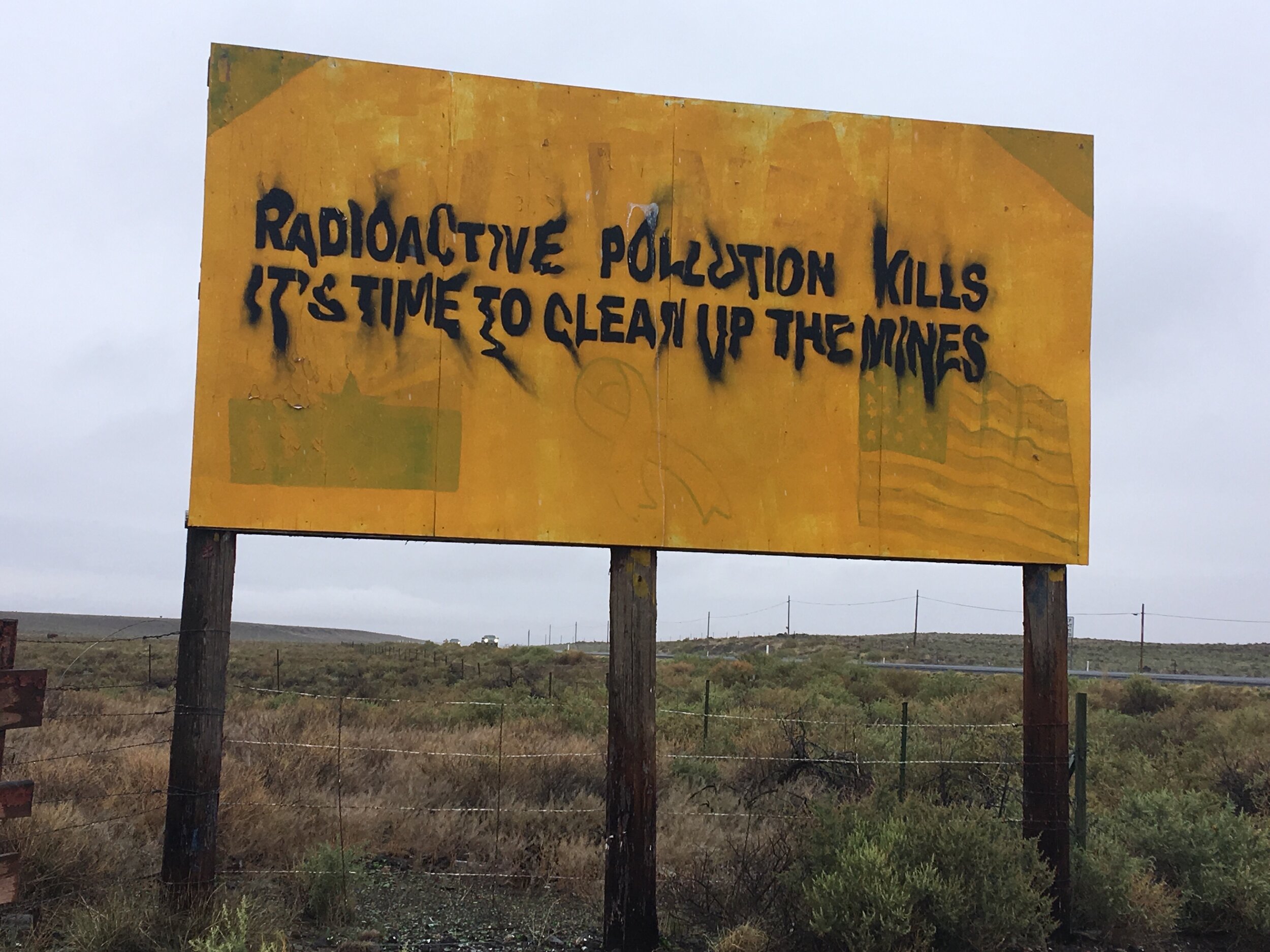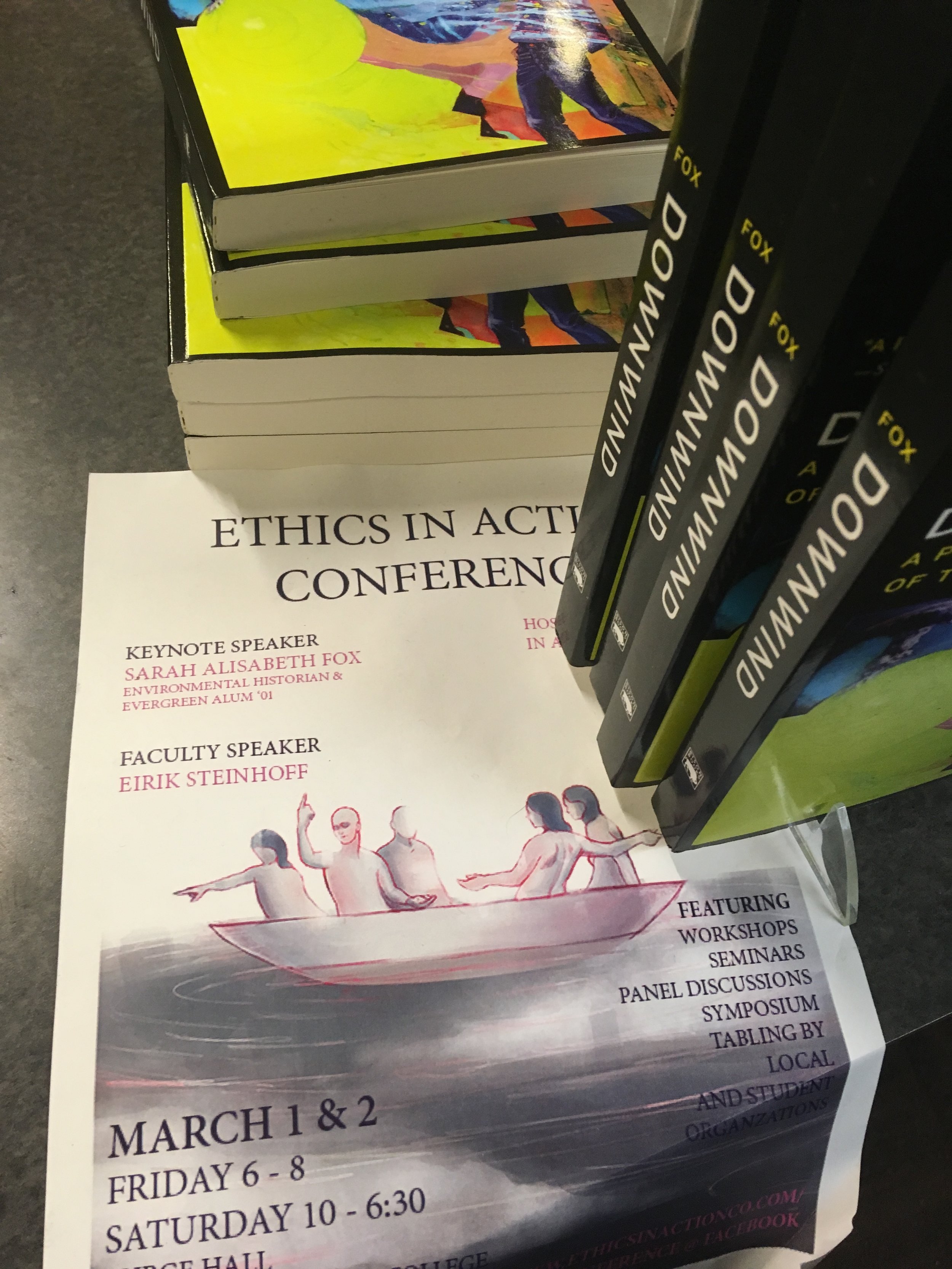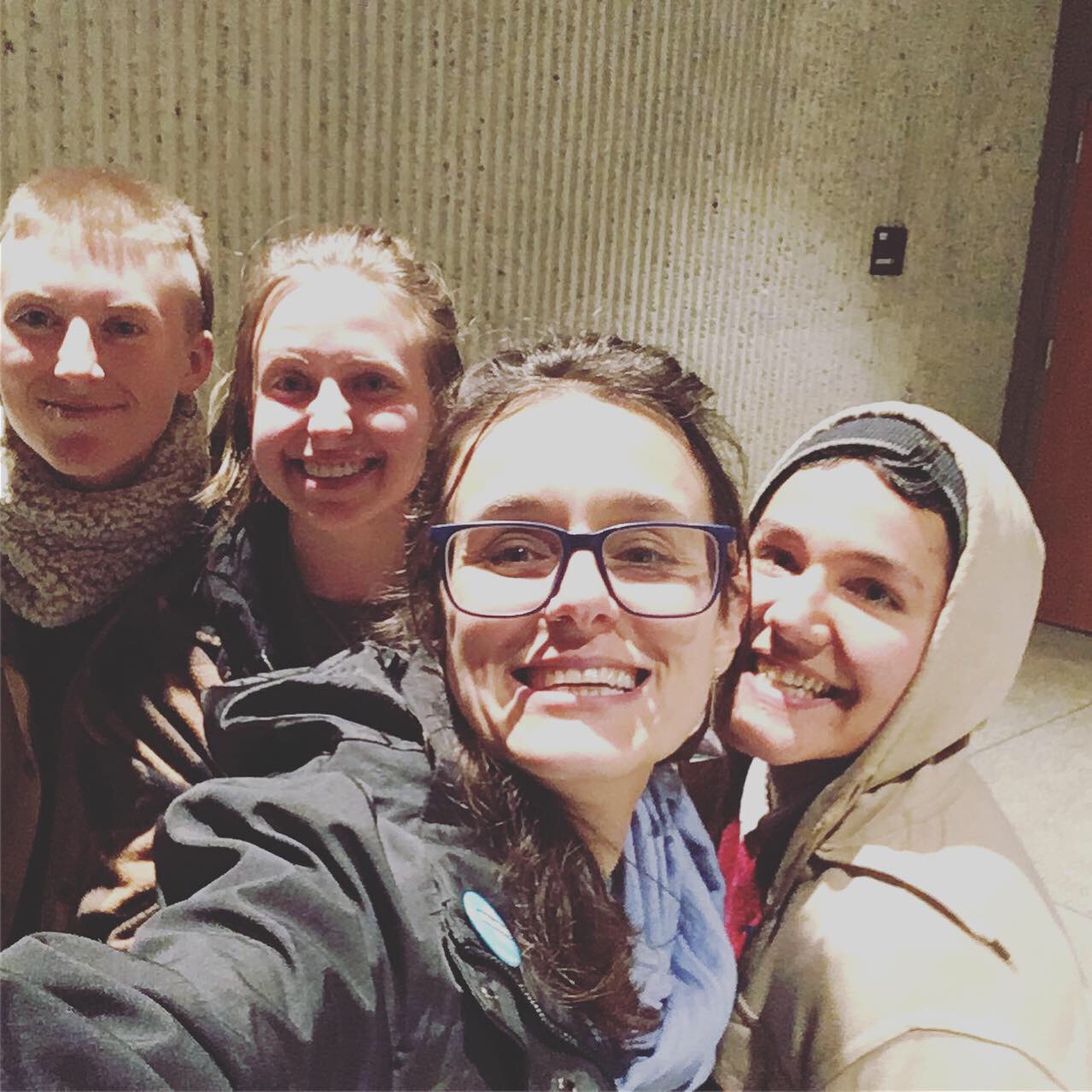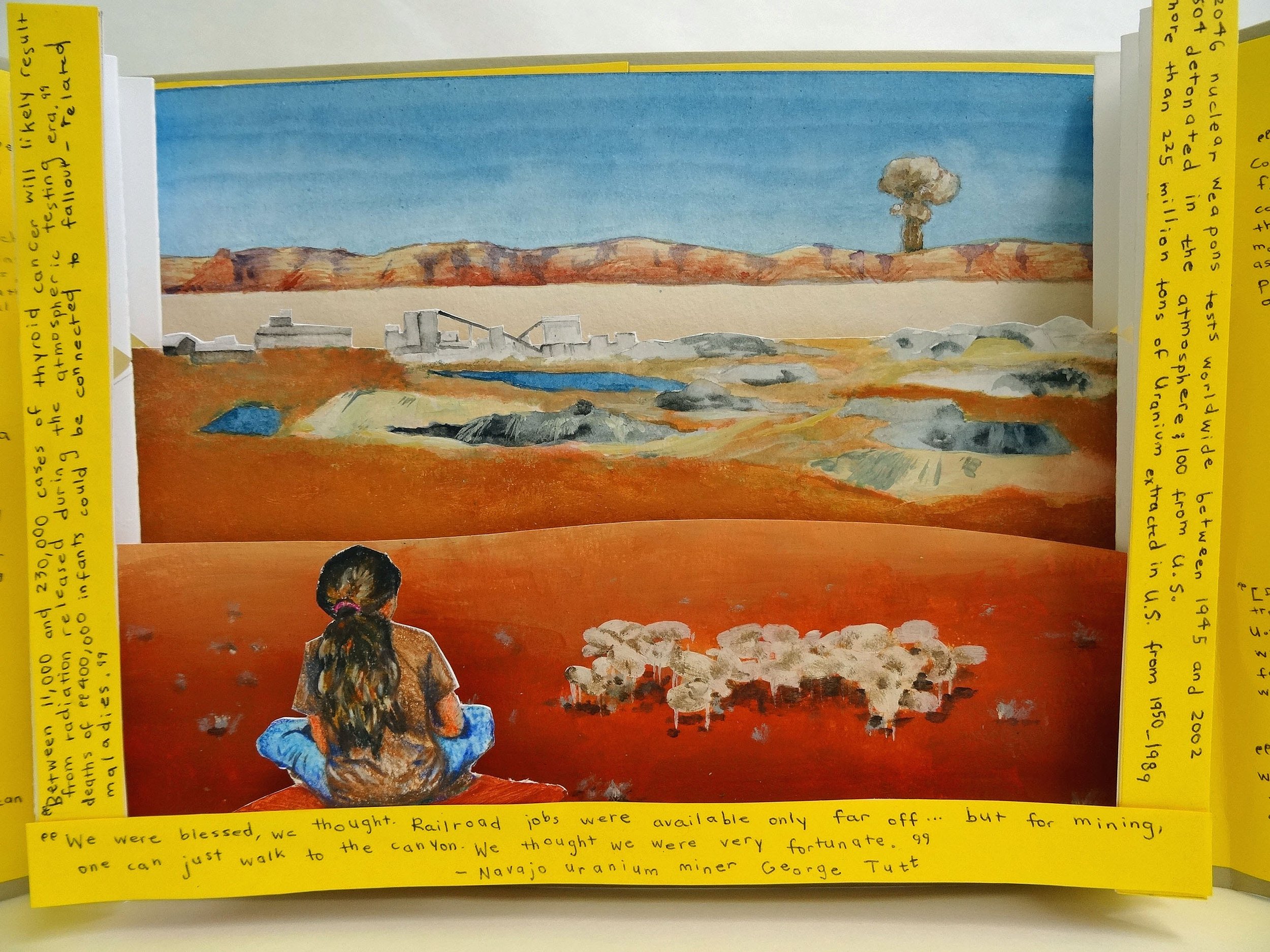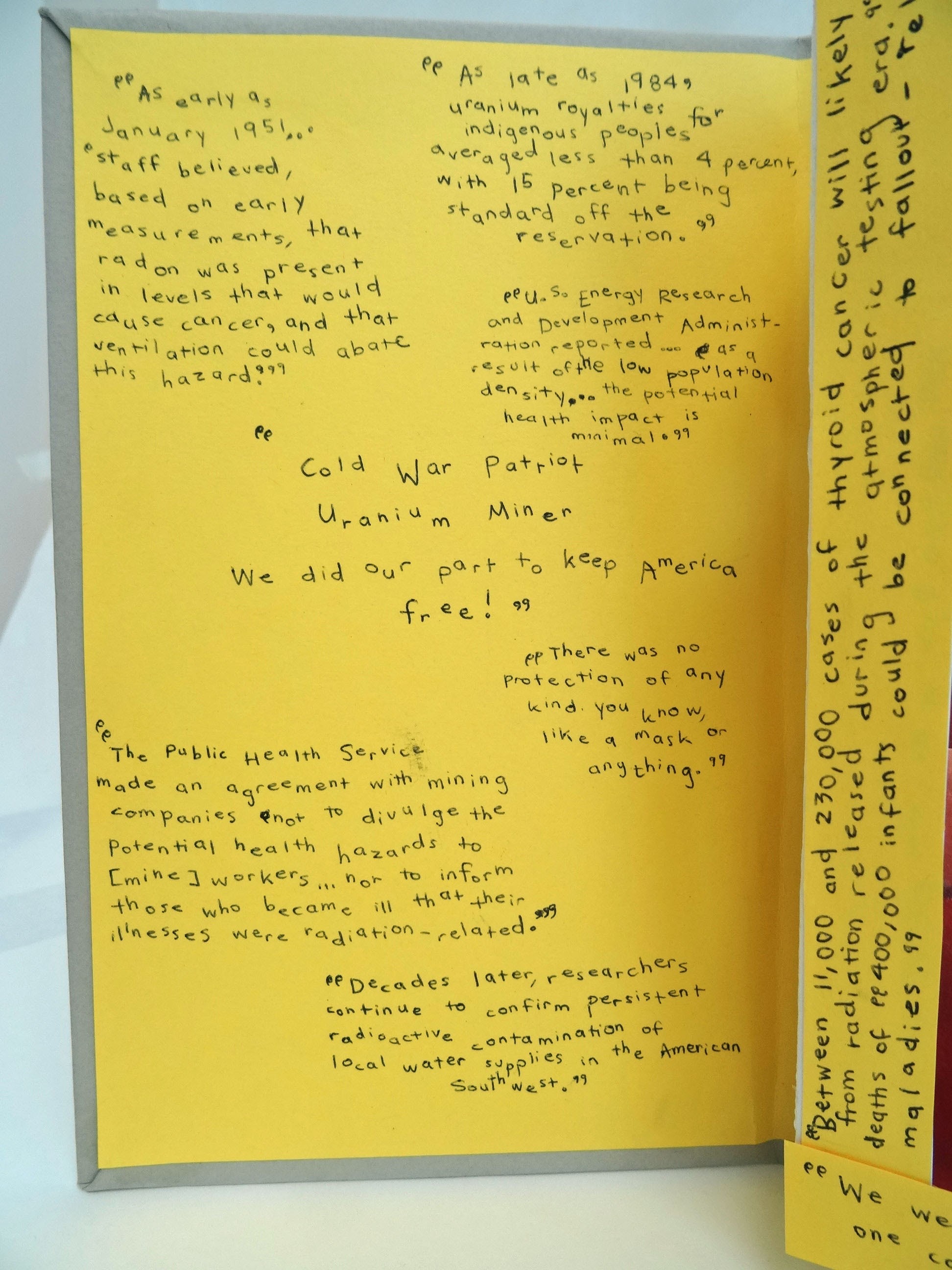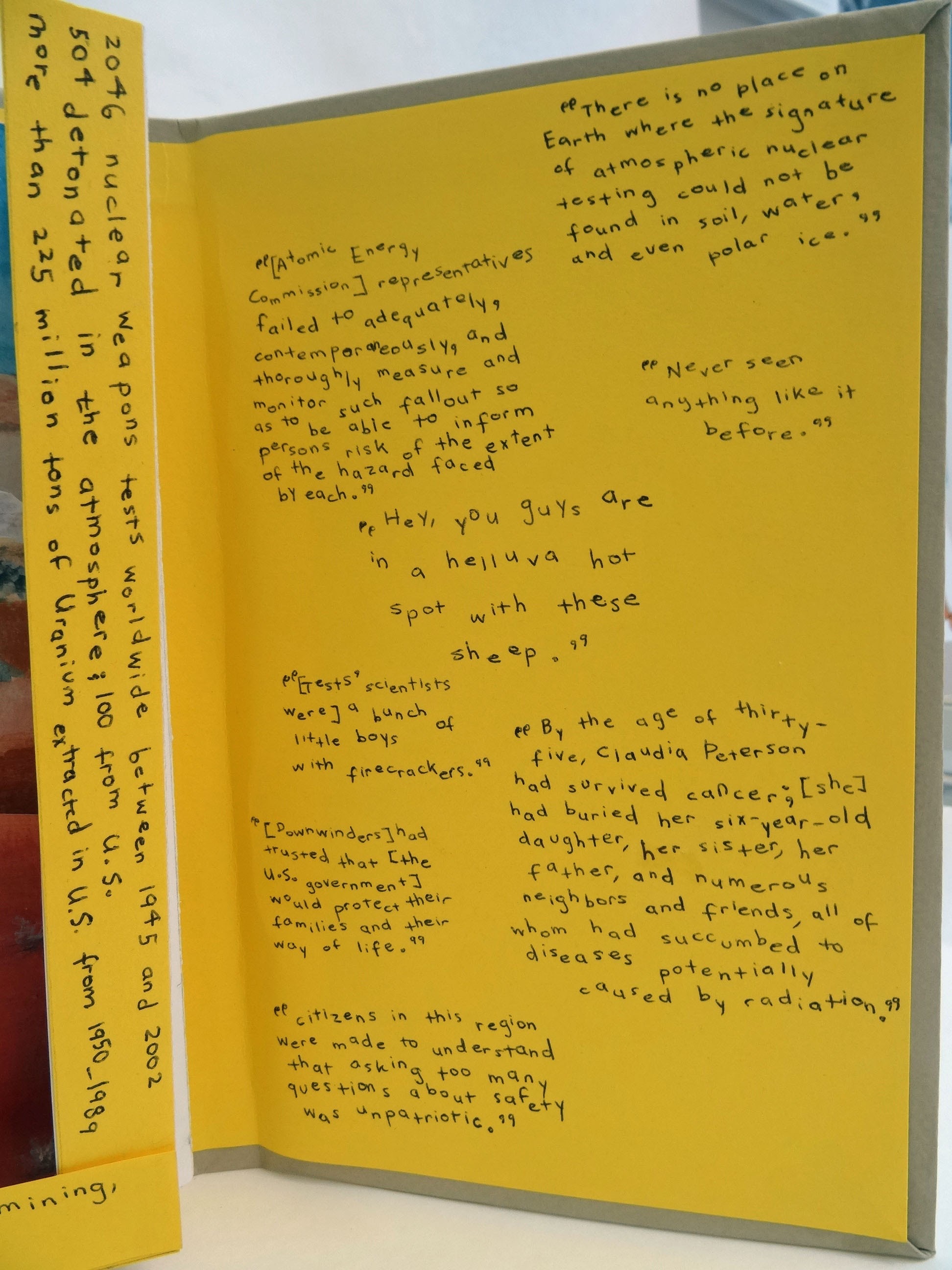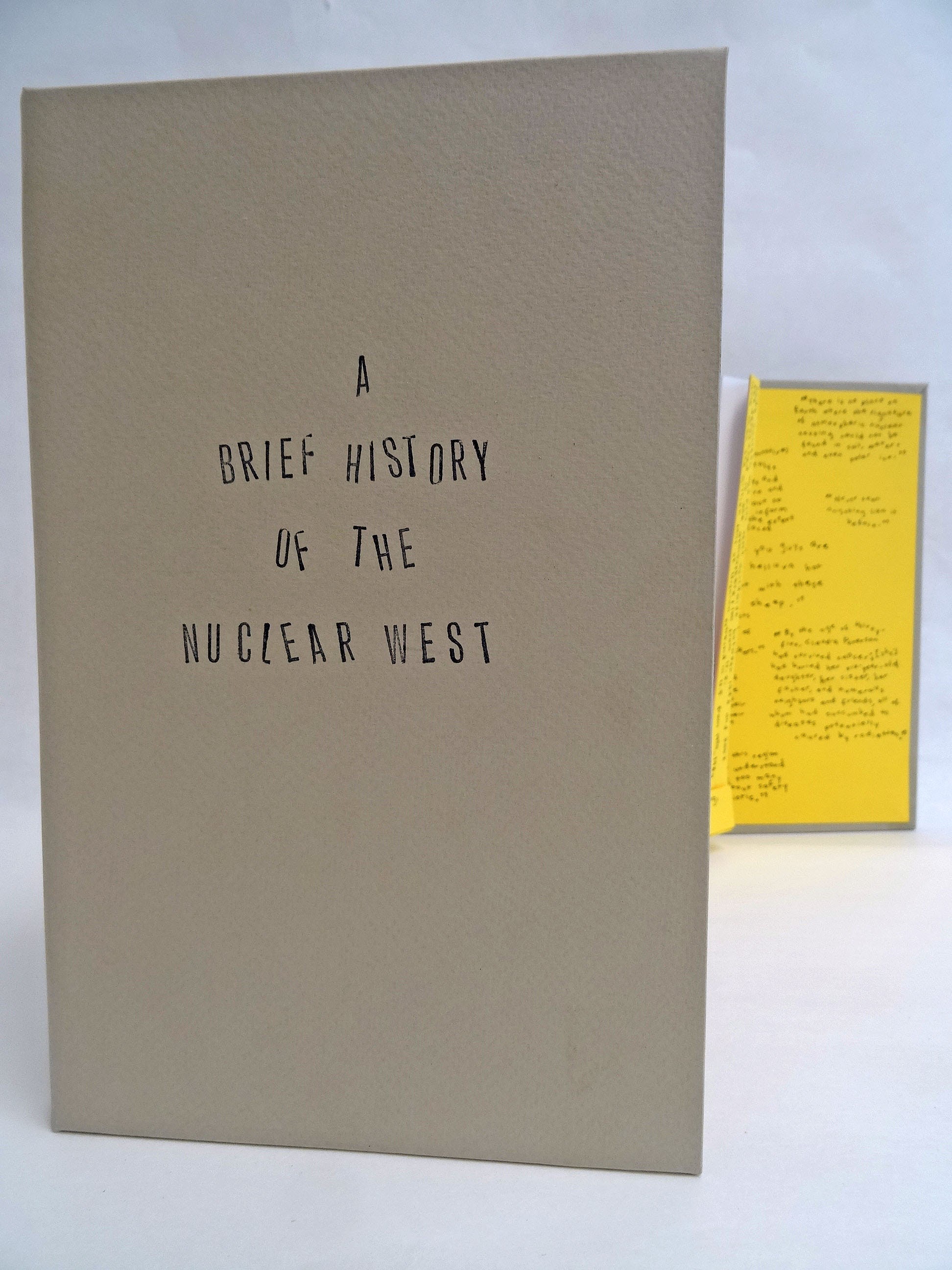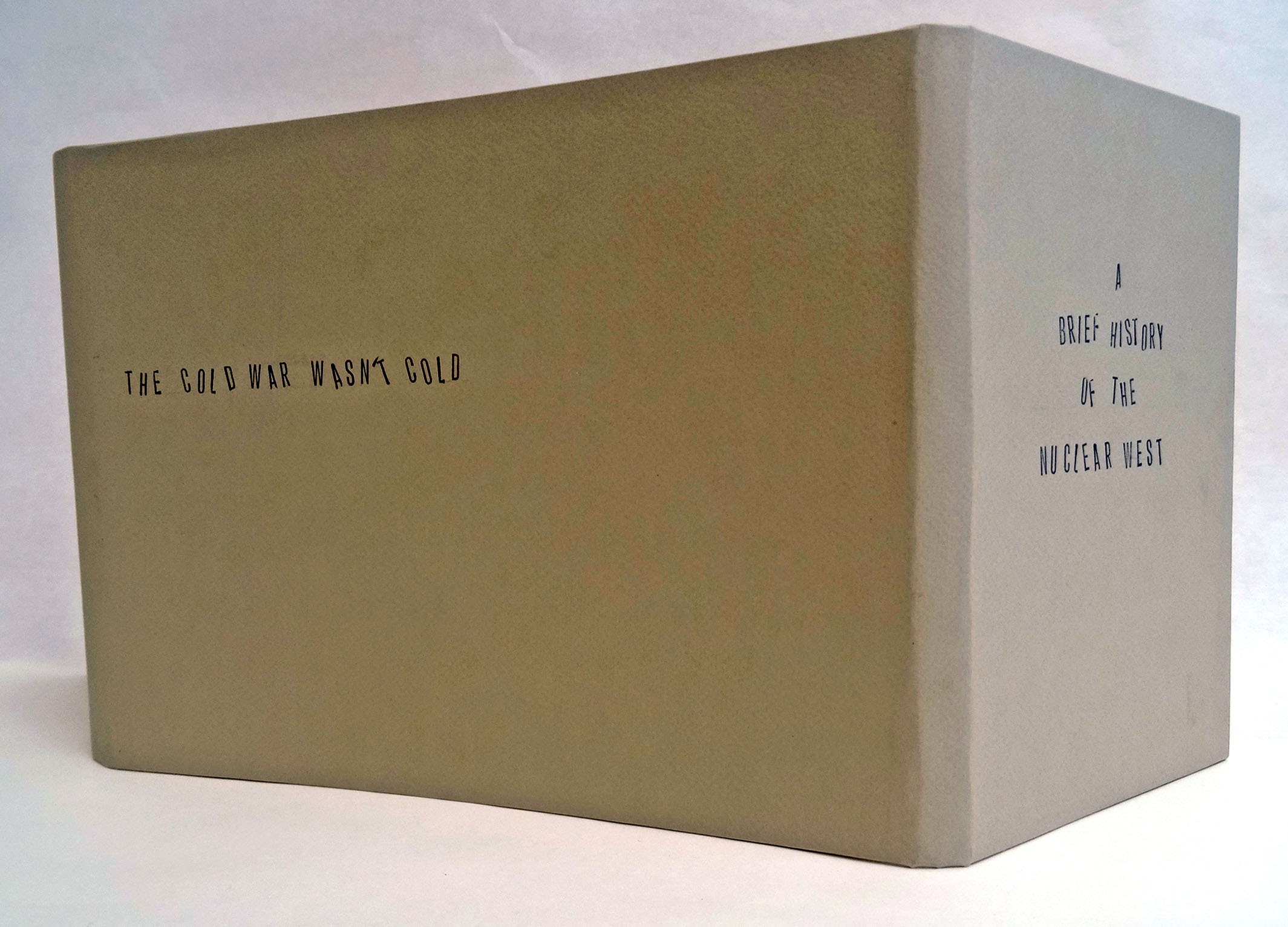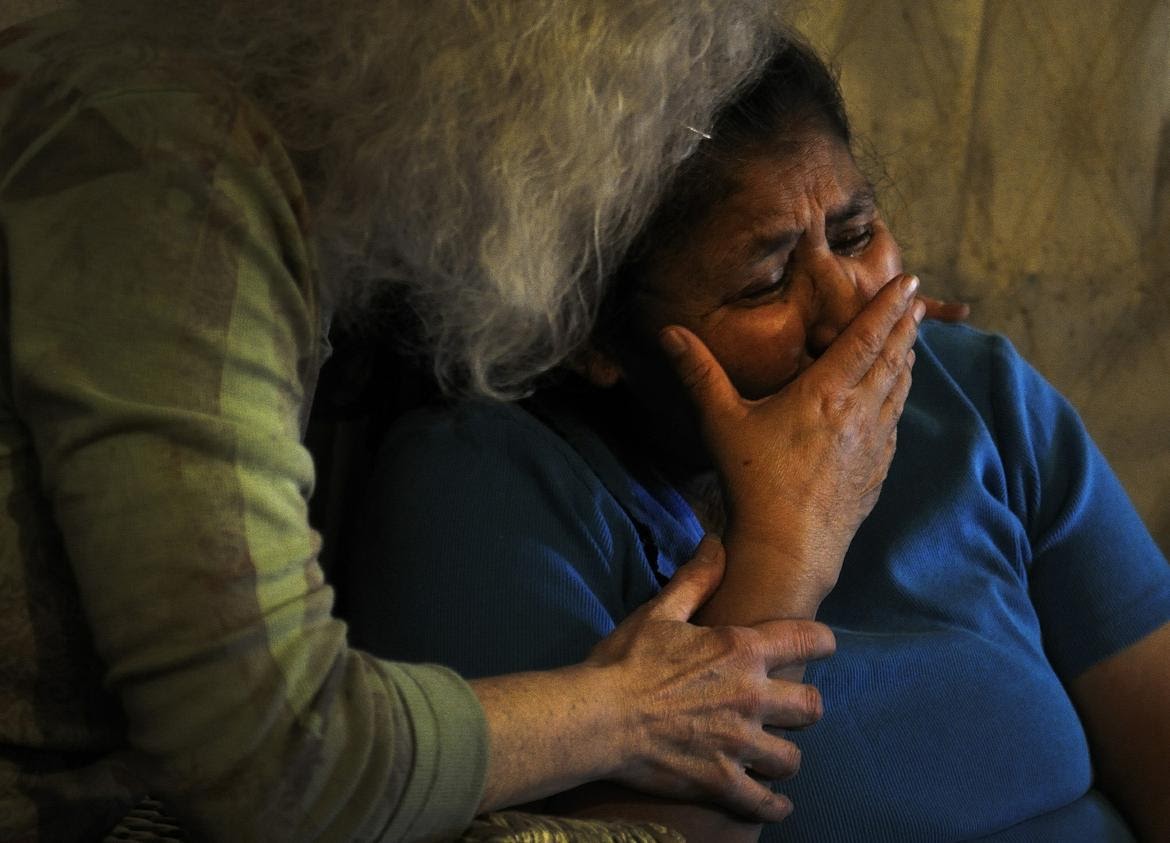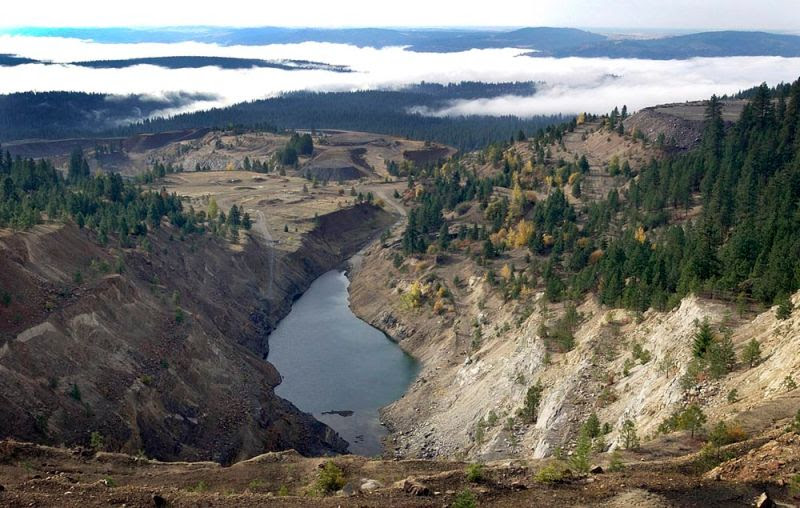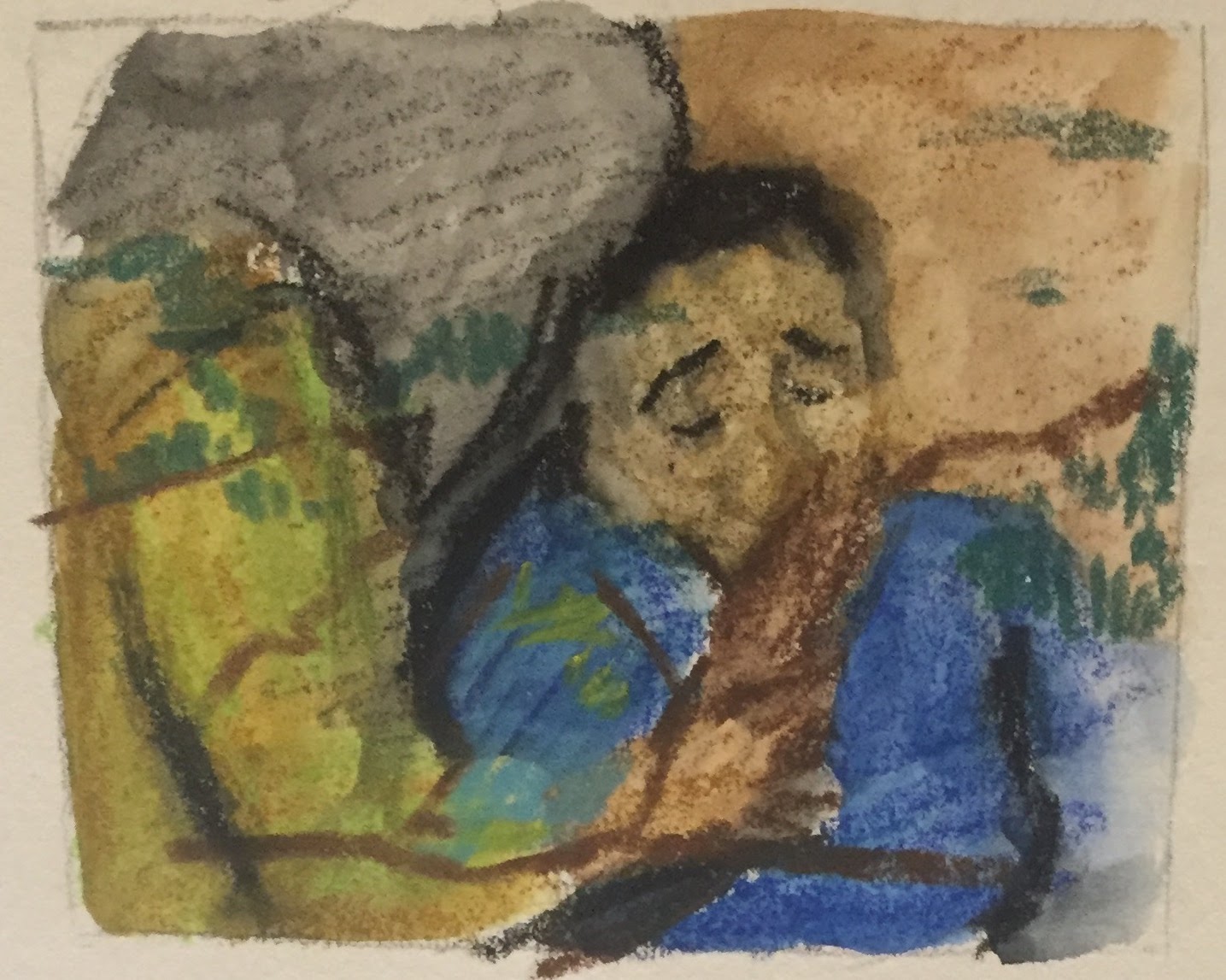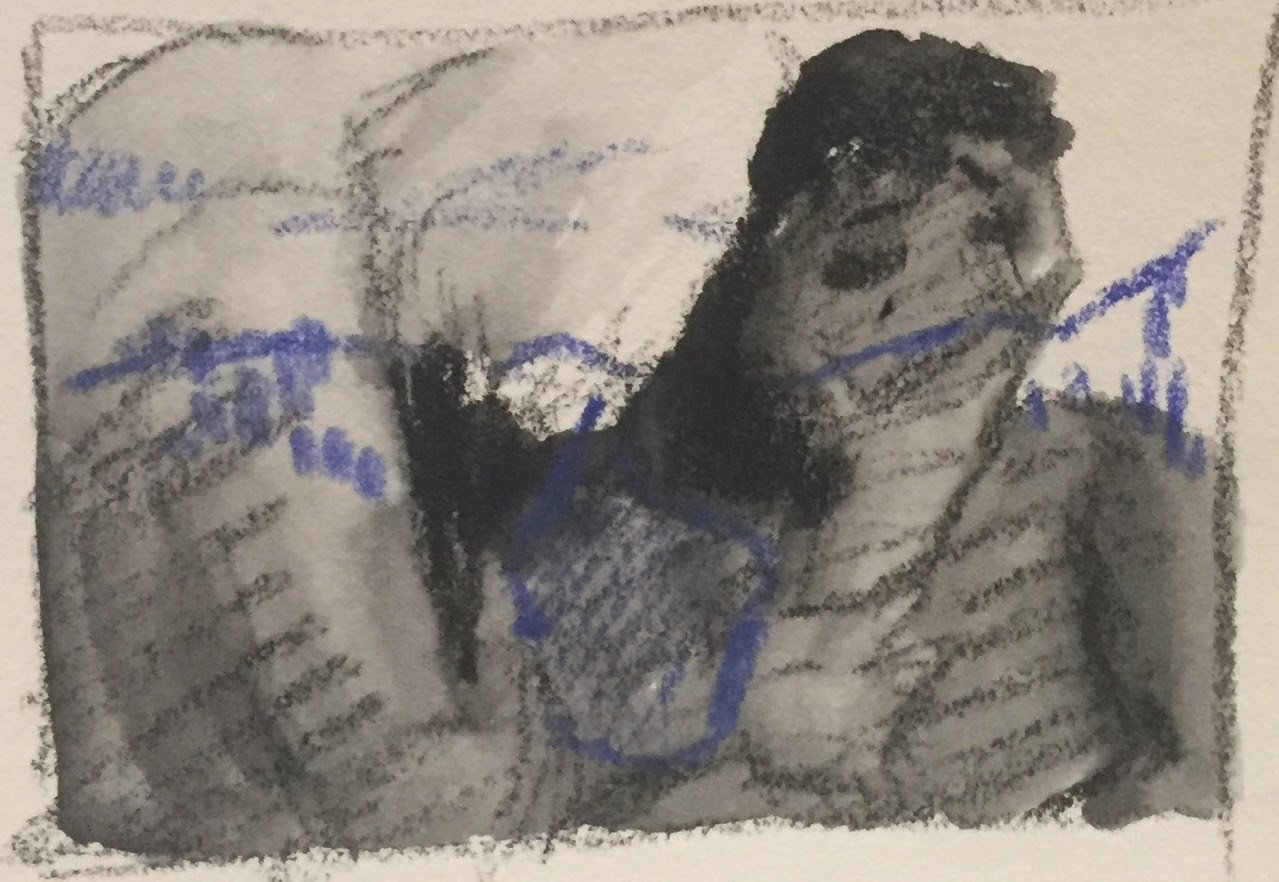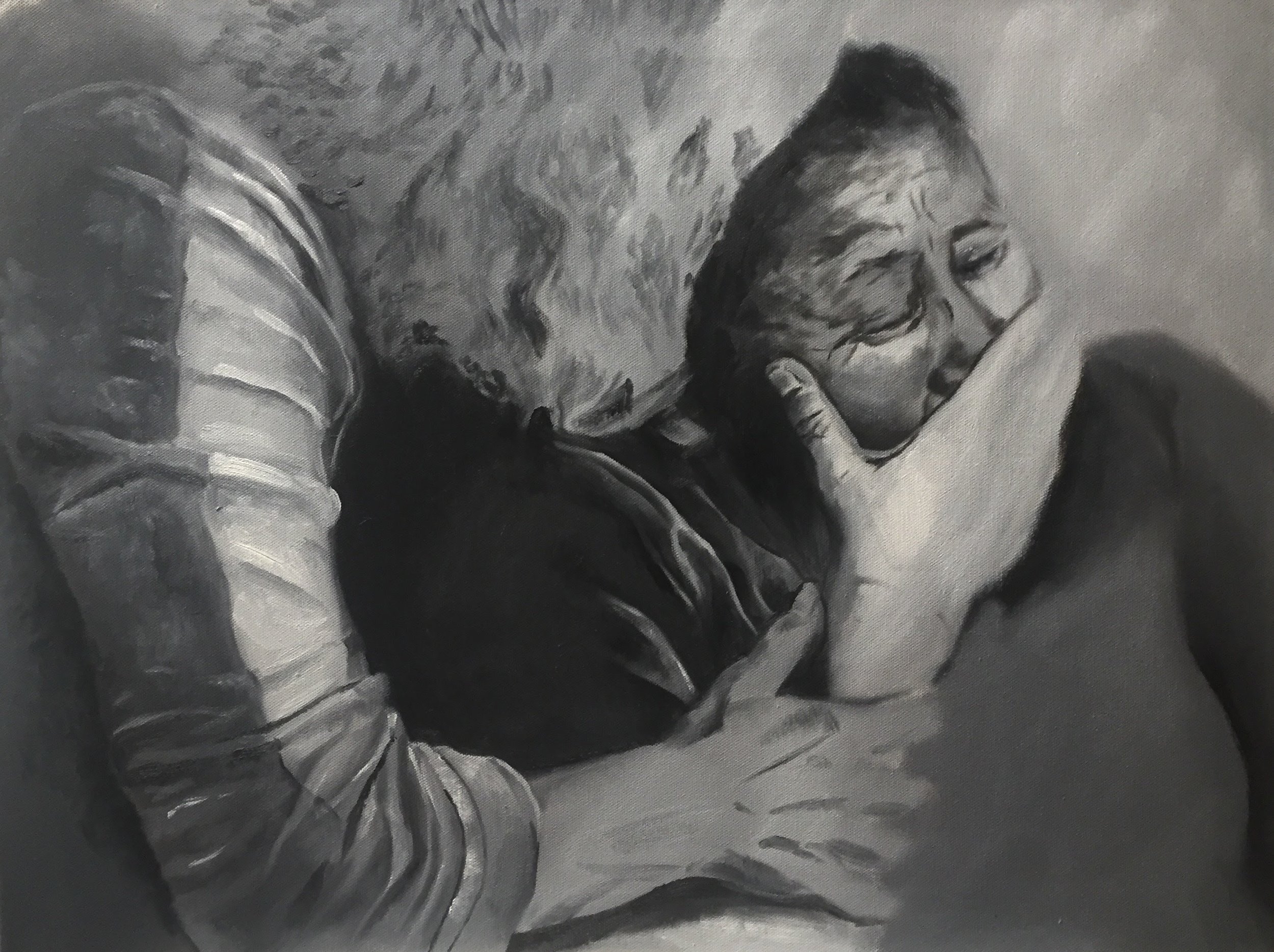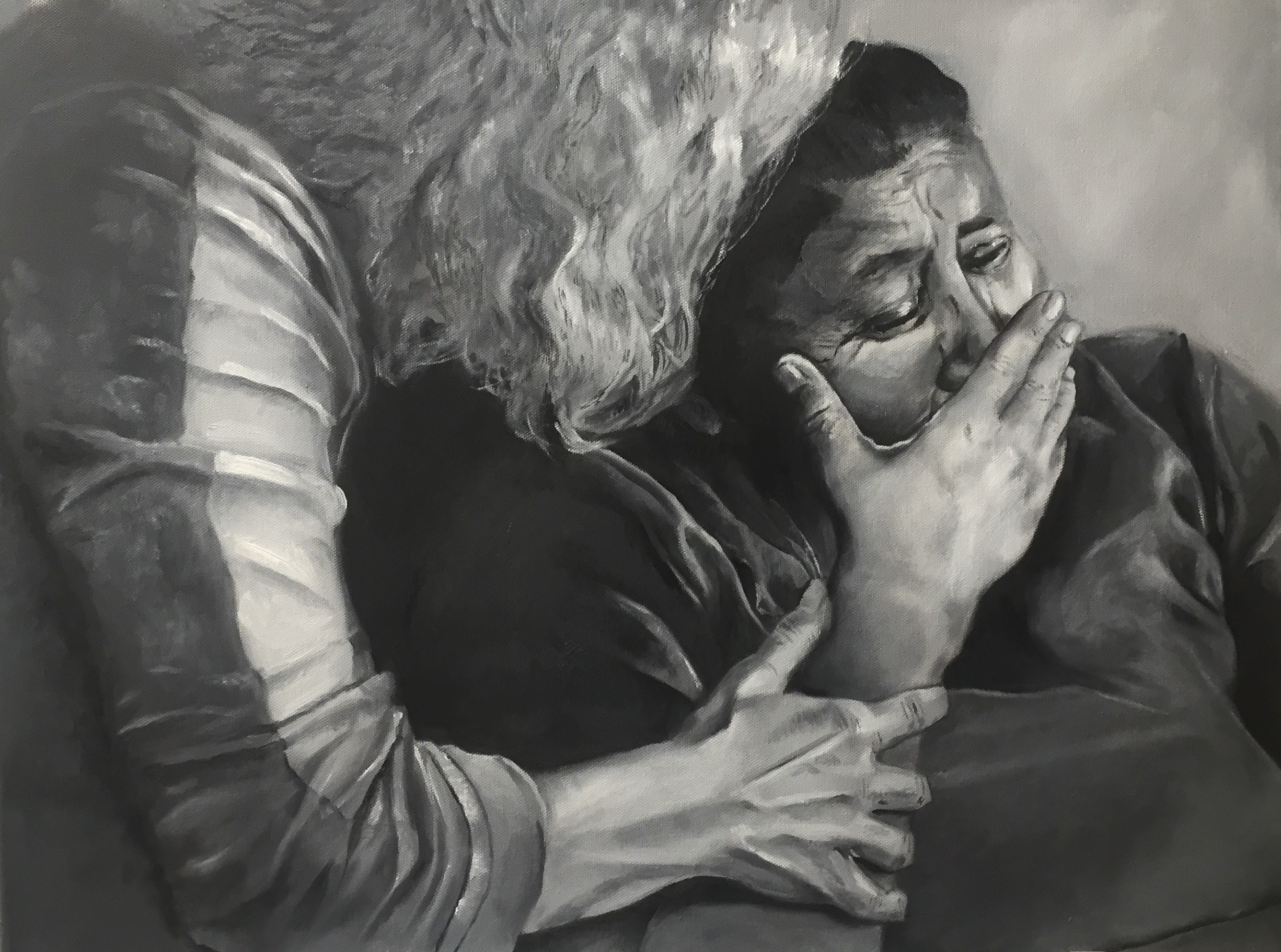Environmental Policy and Decision Making thesis project by Rosalie Triolo, Biology/Environmental Policy and Decision Making/University of Puget Sound 2018
Abstract: Nuclear decision-making has been and continues to be an extremely contentious subject around the world. Though the nuclear climate has changed significantly since the Cold War, the discourse utilized by the United States government from the Cold War to present has changed surprisingly little. During the Cold War era, the U.S. government’s strategy regarding nuclear weapons was based on the National Security Council document 162/2 (NSC 162/2) which was written in 1953. Associated documents including public relations pamphlets such as "Atomic Tests in Nevada," which was made available to the public in 1957, were utilized as a method of easing the growing concerns regarding domestic testing of nuclear weapons. In more recent times, the U.S. has based its strategy on Nuclear Posture Review Reports published by an acting U.S. president—Obama in 2010 (NPR 2010) and Trump, more recently, in February 2018. These documents provide a step-by-step plan regarding the treatment of nuclear weapons not only within the United States, but also around the world. While they were written in vastly different climates, the NSC 162/2 and NPR 2010 utilize similar language to convey similar goals simply changing the enemy: from Russia during the Cold War to North Korea at present. Both documents maintain that the U.S. is one of the strongest military leaders in the world and possesses the ability to protect itself; placing this as the highest issue on its priority list. There is, however, one major difference between the two documents. Whereas the NSC 162/2 has a section dedicated to informing and dealing with citizens of the United States, the NPR 2010 scarcely mentions the government’s plan for interacting with and providing information to the public thus calling into question the relationship between the U.S. government and U.S. citizens in regard to long-term plans for nuclear weapons.
Part I: Introduction
The current state of affairs regarding nuclear weapons in the United States is tumultuous to say the least. Though the U.S. is no longer fighting the Cold War with Russia, during which nuclear proliferation took full force, the topic is still extremely relevant to current defense strategies and policies.
Representing the most powerful military nation in the world, the United States amassed an astonishing number of nuclear devices and conducted extensive domestic testing in the ‘50’s and early ‘60’s under the guidance of president Eisenhower and the national strategy regarding nuclear weapons detailed in the National Security Council document 162/2 (NSC 162/2) published in 1953. During this period, the government worked extremely hard to qualm worries regarding the potential effects of the domestic nuclear testing utilizing public informational documents (Atomic Tests in Nevada, 1957). Since the ratification of both the Partial Nuclear Test Ban Treaty of 1963, which prohibited all nuclear weapons test detonations—with the exception of underground testing, and Non-Proliferation Treaty (NPT) in 1970, which intended to cease the spread of nuclear weapons and technology, research regarding nuclear weapons significantly declined.[1][2] The Comprehensive Nuclear Test-Ban Treaty (CTBT) was then passed in 1996 creating a multilateral ban on all nuclear explosions by the United Nations causing an even steeper decline in development.[3] In compliance with these treaties, the majority of the United States nuclear arsenal was developed and tested during the Cold War almost 30 years ago. As such, many of the weapons are in need of repair and the United States must either work toward re-building and strengthening its nuclear arsenal or begin the long road of dismantling nuclear weapons on a global scale. In a speech given in Prague in 2009, Obama called for a world free of nuclear weapons and in his subsequent Nuclear Posture Review Report (NPR 2010) detailed how he planned on starting down this long road.
Though these two periods represent extremely different eras in regard to both domestic and national nuclear agendas, there are still extremely important parallels between these government sanctioned and authored reports. It is important to understand these government documents and assess the strategies that they utilize in the spreading of information seeing as these strategies are not isolated to these documents. The Trump administration directed another Nuclear Posture Review in 2017 which will be released in January of 2018, making it even more important to analyze these documents and understand what they mean in a current context. Additionally, tensions between the United States and North Korea have continued to increase over the past few years with North Korea displaying its lack of involvement in the Nuclear Non-proliferation Treaty time and time again. With the insecure nature of future endeavors in global nuclear weapons in conjunction with closed-door policies present in the government, it becomes imperative that we understand the patterns of government disclosure in the past in order to interpret the pertinent government documents that will be released in the near future.
Part II: Background
i. Cold War:
The most powerful weapons to have ever been developed ended World War II in a power move by president Harry S. Truman: the first nuclear bombs that the world had ever witnessed were detonated over Hiroshima and Nagasaki on August 6th and 9th, respectively, of 1945. The new weapon was in a category of its own and whomever possessed the largest nuclear stockpile possessed the most power. Truman claimed that this measure was taken to both ensure the end of the war as well as prevent further loss of American lives. The decision, however, was not without controversy and there was speculation that the bombs were dropped in order to intimidate the Soviet Union. Regardless of the true motives, Stalin viewed the move as anti-Soviet, giving the upper hand to the U.S. for postwar negotiations. In response, Stalin signed a decree fast-tracking the Soviet nuclear project just 11 days after the power display, on August 20th.
In the following year, there were multiple diplomatic issues that needed to be addressed by each of the allies. President Truman believed that in order to ensure peace for the prolonged future, the United States, along with members of the Grand Alliance, needed to cultivate bonds that were not only tied to having common enemies but were also truly forged alliances that could sustain past the initial victory. Unfortunately, this was much easier said than done seeing as each nation had individual needs and where they agreed with one another on some aspects, there were still large differences in other areas. The Soviet Union, in particular, following three invasions over the span of just one hundred and thirty years, decided that its primary goal was to seek security via land acquisition, and spheres of influence. Communist ideology in conjunction with xenophobia led to a deep distrust of Western motives. While both the United States and the USSR wanted peace; the means by which to get there were contradictory. Because of the fission in approach, the Grand Alliance became nothing but a dream and though they both desired peace, their inability to merge perceptions led to the exact opposite: The Cold War.[4]
Following these failed negotiations, the United States began to expand its nuclear arsenal and in September of 1948, Truman endorsed National Security Council paper 30 (NSC 30) titled “Policy on Atomic Warfare.” The document concluded that the U.S. needed to be able to “utilize promptly and effectively all appropriate means available, including atomic weapons, in the interest of national security and must therefore plan accordingly.”[5] This move, in conjunction with the Soviet shift towards a nuclear world, continued to increase tensions and nuclear tactics became the central element to both U.S. and Soviet strategy. The relations continually grew worse and though there was hope that the two nations would mend relations, Stalin adopted a policy that was stubborn and inflexible.
In January of 1950, just months post-Soviet nuclear test, North Korea and China became involved when Stalin told North Korean leader Kim Il Sung that they could combine forces. In anticipation of the lethal bond, the United States intervened and UN forces moved into North Korea and China entered the war shortly following. When China entered the war, alarms went off in Washington and the US responded in a press conference by insinuating that they may utilize an atomic weapon which caused public outcry. Despite the public display, there was no true threat of Truman utilizing the weapons; he was well aware that their costs well outweighed their benefits and had no intention of utilizing them ever again. When Eisenhower took over the presidency, however, the actual use of nuclear weapons became more present as Eisenhower believed nuclear weapons to be one of the United States’ biggest assets.
Though the U.S. possessed the technology first, the Soviet’s quickly caught up and tested their first nuclear weapon on August __ of 1949. In response the Nevada Nuclear Test Site was established in 1951. The site constituted a 1,375-square mile parcel of land located in the southern part of the Great Basin to be used as a testing ground for weapons in the name of national security. “Superbomb Mike” test was conducted on November 1st of 1952 with a 10 megaton yield, more than 1,000 x more powerful than the bomb dropped on Hiroshima, thus establishing the United States as the leader in the newly sparked arms race. In the following years, the U.S. continued to develop and test nuclear weapons domestically in order to insure complete control and secrecy over the production and test results (Appendix table 1). Between 1951 and 1992, when a worldwide moratorium was placed on nuclear testing, 928 tests of varying size were conducted within the boundaries.1[6] Additionally, the United States located domestic sources of uranium, the desired radioactive material used to construct atomic bombs, and began the full-blown production of a nuclear weapon stockpile. Though the industry was now much more protected from outside influences, there were other issues. The detonation of these tests produced large amounts of radiation and many people who lived in the Great Basin, the region downwind of the test site, were exposed to these dangerous clouds.[7]
Tensions continued to rise as the Korean War continued and both nations developed and tested more nuclear weapons. Yet, on March 5, 1953, Joseph Stalin died thereby fundamentally changing the course of The Cold War. Though the Cold War continued, some of Russia’s policies now lined up more with the United States’. With continued rising tension, the United States began producing nuclear weapons at unprecedented rates growing its stockpile from 369 to over 27,000 between 1950 and 1962. In the same time, the Soviet Union stockpile had only grown to 3,300. By 1960, it was clear that the version of future war initially shared in 1950 was vastly different constituting a much more comprehensive attack on either side resulting in World War III.
Then, in October of 1962, Khrushchev deployed a group of Soviet forces to Cuba with the goal of building a submarine base claiming he was worried that the U.S. would invade Cuba. President Kennedy announced that the U.S. would impose a naval quarantine and told the Soviet’s to remove the missiles. Kennedy also placed his military forces on high alert and assembled forces in Florida in preparation for an invasion of Cuba. On October 28th, the crisis was resolved with Khrushchev agreed to withdraw his missiles from Cuba in return for the promise that the United States would not invade Cuba. This represented a turning point in the war as it truly drove home the idea that the potential for war was extremely dangerous and should be avoided. The crisis provided the impetus to discuss a nuclear test ban more seriously and make the relationship between the two nations more stable as to reduce the risk of war. As such, the Partial Nuclear Test ban treaty of 1963 was passed which prohibited the above ground/atmospheric testing “or any other nuclear explosion” of nuclear devices.1 Then, in 1970, the Non-Proliferation Treaty (NPT) was passed with the goal of ceasing the spread of nuclear weapons and technology with the eventual goal of nuclear disarmament.2 A complete ban on nuclear testing, the Comprehensive Nuclear-Test-Ban Treaty followed in 1996 creating a multilateral ban on all nuclear testing.3 [8]
“seek the peace and security of a world without nuclear weapons” –Obama in Prague, April 2009
Part III: Document Analysis
i. A Report to the National Security Council: Basic National Security Policy
In response to growing tension between the United States and Soviet Russia, Executive Secretary James S. Lay helped pen the National Security Council Paper No. 162/2 (NSC162/2) which was approved by President Eisenhower on October 30, 1953. The document was deemed Top Secret and was only read by senior officials within the government as it had pertinent information that could have been extremely detrimental had the soviet’s gotten their hands on it. The document assesses the current relationship between the U.S. and the USSR as well as details the next step for the US in relation to its nuclear arsenal in the face of the communist threat. Not only does it discuss the necessity of developing nuclear technology but it also includes extensive discussions regarding military spending in conjunction with a sound American economy as corner stones of winning the Cold War. As it was Top Secret, there was no part of it written for the public and had a specific target audience of those possessing high-ranking positions within the United States government.
The document begins with a brief summary about the Soviet Union’s atomic weapon stockpile that poses a significant threat to the United states. Though they deem a short-term attack unlikely, the United states should maintain “sufficient atomic weapons.” Additionally, the US will make their intentions to respond with military force well known to the USSR and Communist China as well as making nuclear weapons “as available for use as other weapons.”
The document then provides three objectives in order to ensure the security of the United States:
1. the US will continue the development and maintenance of:
a. “A strong military posture, with emphasis on the capability of inflicting massive retaliatory damage by offensive striking power;
b. U.S. and allied forces in readiness to move rapidly initially to counter aggression by Soviet bloc forces and to hold vital areas and lines of communication; and
c. A mobilization base, and its protection against crippling damage, adequate to insure victory in the event of general war.”
2. “Maintenance of a sound, strong and growing economy, capable of providing through the operation of free institutions, the strength described in [1.] above over the long pull of rapidly and effectively changing to full mobilization.”
3. “Maintenance of morale and free institutions and the willingness of the U.S. people to support the measures necessary for national security” (5-6).
In short, the United States will continue to expand its nuclear testing and development and the associated mobilization processes and locations in order to be able to respond to any aggression made by the USSR; maintain an extremely strong, growing economy that is able to provide the necessary funds for war; and encourage the people of the U.S. to support the government by all means necessary.
The document later talks more specifically about the research to be conducted regarding nuclear weapons stating that the U.S. will, “conduct and foster scientific research and development so as to insure superiority in quantity and quality of weapons systems, with attendant continuing review of the level and composition of forces and of the industrial base required for adequate defense and for successful prosecution of general war” (7). In order to maintain their superiority as the primary leading nation, they must maintain military superiority and be ready for war at any moments time. “…The major deterrent to aggression against Western Europe is the manifest determination of the United States to use its atomic capability and massive retaliatory striking power if the area is attacked.” (11)
The Document also highlights how important it was for the U.S. to maintain good relations with its allies as well as provide protection as one of the leading military nations stating, “our allies are … dependent on the United States for their security… The United States should be able for the foreseeable future to provide military aid, in more limited amounts than heretofore, to our essential allies” (9). By maintaining these alliances, they are a much more powerful force against the USSR. In partnering with these other nations, the U.S. commits itself to responding with nuclear force if the USSR attacks any of them in such a capacity and, thereby, unites them on all fronts against Communism. “Our allies must be genuinely convinced that our strategy is one of collective security. The alliance must be rooted in a strong feeling of a community of interest and firm confidence in the steadiness and wisdom of U.S. leadership” (20) In this statement, the document makes two claims: one, that in order to maintain a secure world and nation, the allies must all stick together—there is power in numbers—and two, that the United States is the leader of this military strategy and that they possess the knowledge and military prowess to make the calls.
The second portion of the document discusses the necessity of the United States to not only maintain but grow the economy in order to protect the security of the nation stating, “Not only the world position of the United States, but [also] the security of the whole free world, is dependent on the avoidance of recession and on the long-term expansion of the U.S. economy. Threats to its stability or growth, therefore, constitute a danger to the security of the United States and of the coalition which it leads…” (14).
The third portion of the document focuses heavily on the support of the American people and how integral it will be to win the war. The document claims that, “support for the necessary security programs, based upon a sound productive system, is ultimately dependent also upon the soundness of the national morale and the political willingness of the country to support a government which it feels is holding the proper balance between the necessary sacrifices and the necessary defense. Accordingly, the American people must be informed of the nature of the Soviet Communist threat, in particular the danger inherent in the increasing soviet atomic capability; of the basic community of interest among the nations of the free world; and of the need for mobilizing the spiritual and material resources necessary to meet the Society threat.” (17). It is important to note that though the quote states it is necessary to make the public aware of the threat it faces from the Soviet Union, it makes no mention of an open-door policy regarding the nuclear decisions that occur within the country. The balance that the United States must strike between “necessary sacrifices and necessary defense” is extremely precarious and in order to maintain this balance, it will require the divulging of some information but not all.
In sum, it concludes that, “the risk of Soviet aggression will be minimized by maintaining a strong security posture, with emphasis on adequate offensive retaliatory strength and defensive strength. This must be based on massive atomic capability, including necessary bases; an integrated and effective continental defense system’ ready forces of the United States and its allies suitably deployed and adequate to deter or initially to counter aggression, and to discharge required initial tasks in the event of a general war’ and an adequate mobilization base’ all supported by the determined spirit of the U.S. people” (19).
ii. Atomic Tests in Nevada:
Though they were published five years apart, the Atomic Tests in Nevada booklet can be viewed as a public relations portion of the NSC 162/2 which was deemed Top Secret at the time of publication.
As discussed in the analysis of the NSC 162/2, there was little information available to the public regarding any of the nuclear testing or development that was occurring during this time period as it was deemed too risky for national security for the information to be divulged. While this sentiment reigned supreme throughout the government, citizens of the United States grew more and more uneasy as domestic testing continued with little information available regarding its potential consequences. In an effort to control the rhetoric surrounding these tests, the Atomic Energy Commission produced a number of informational materials one of which being The Atomic Tests in Nevada, published in 1957.
The government-endorsed booklet was distributed to schoolchildren throughout the downwind region: Utah, Arizona, and New Mexico. The booklet details supposedly what was going on at the test site as well as the national security implications of halting domestic nuclear testing. Additionally, the booklet included an appendix with detailed information about the specifics of radiation and testing. The brief analysis that follows is by no means comprehensive; and simply brings to the forefront some of the major points that the booklet makes.
The booklet begins with a quote from President Dwight D. Eisenhower on October 23, 1956:
“…until that international trust is firmly secured, we must—and do—make sure that the quality and quantity of our military weapons command such respect as to dissuade any other Nation from the temptation of aggression…Thus do we develop weapons, not to wage war, but to prevent war…not primarily weapons for vaster destruction—but weapons for defense of our people against any possible enemy attack, as well as knowledge vital to our whole program of Civil Defense…We must continue—until properly safeguarded international agreements can be reached—to develop our strength in the most advanced weapons—for the sake of our own national safety, for the sake of all free Nations, for the sake of peace itself.” (emphasis added)
This quote exemplifies the relationship between the United States and nuclear weapons, just as the NSC 162/2 did, suggesting that the U.S. would continue build and develop an extensive nuclear arsenal capable of extreme destruction. It is made apparent, however, that the production of such weapons is being done in order to promote “peace.” The quote suggests that the United States is both developing and testing these weapons simply in response to rising tensions with Soviet Russia. Utilizing phrases that emphasize the fact that the U.S. is supposedly avoiding war and advocates for peace makes the production of these weapons that could kill thousands, if not millions, in a single strike much more palatable to the public. Eisenhower makes it perfectly clear that until the United states possesses an extremely strong, and advanced nuclear stockpile, the development of such weapons would persist. And perpetuates the image that the United States has the ability to protect its people with the help of the nuclear weapons being developed.
The first section of the booklet titled, “Atomic Testing in Nevada,” provides a broad overview of the number and types of tests that have been performed at the site and attempts to provide information that would qualm worries, stating that the tests done at the site “…ranged in yield from less than 1 kiloton up to considerably less than 100 kilotons. (A kiloton is equivalent to 1,000 tons of TNT)” (emphasis added, 1). While this may appear to present information to the public, the use of the phrase “considerably less than 100 kilotons” means virtually nothing. There is no standardized meaning for ‘considerably less than’ and, as such, while this piece of information may provide some sort of comfort seeing as it utilizes numbers which, historically, make individuals more trusting of results (SOURCE) the numbers are, in fact, useless. Next, the booklet claims that despite the relatively low yield that the tests produced, they have “clearly demonstrated their value to all national atomic weapons programs…Because of them our Armed Forces are stronger and our Civil Defense better prepared” (1). Again, the statement fails to provide adequate information and makes no mention of how the tests have benefited the public and how they have “demonstrated their value.”
The next section, “Protection of the Public,” directly addresses individuals living near the Nevada Test Site, saying that they are, “in a very real sense active participants in the Nation’s atomic test program…Nevada tests have helped us make great progress in a few years, and have been a vital factor in maintaining the peace of the world” (2). The statement pulls at citizens sense of patriotism and personalizes their role in the protection of the United States, giving the illusion that these individuals have agency and that their allowance of the tests provides them a higher status. Again, the utilization of the word “peace” indicates that these tests are not being done to promote war but to promote exactly the opposite.
A subheading of Protection of the Public, titled “potential Exposure is Low,” discusses the exposure that could occur to individuals within these downwind areas. The booklet claims that though the potential for exposure to secondary effects of the detonations such as the “flash, blast, and radioactive fallout,” are low, they can be further reduced by “continued cooperation” (3). This insinuates that the individuals in the areas of higher radioactive fallout have the ability to avoid exposure to these harmful products from the tests—it is important to note that, at no point in this section, does the booklet indicate what type of “cooperation” is required to reduce these risks. “Every Test is Evaluated” follows this section and states, “every test detonation in Nevada is carefully evaluated as to your safety before it is included in the schedule. Every phase of the operation is likewise studied from the safety viewpoint” (4). The next few subheadings of the booklet discuss the overall goal of minimum exposure, providing information about some improvements they have made regarding forecasting of weather, as well as increased precision in predicting where fallout will go, blast intensity and location. These statements, again, fail to provide detailed information in regard to what is being evaluated. When the statements are evaluated further, in conjunction with additional AEC documents, it is true that the tests were evaluated extensively prior to their detonation but that wasn’t necessarily to the benefit of the individuals reading this booklet seeing as the AEC was looking at wind patterns that would allow for the fallout to be directed over the great basin area, an area of ‘sparse population; which happens to be the area in which the target audience resides.
“Fallout From Nevada Tests,” the second section of the booklet provides a discussion of the fallout that occurs from the tests, and refers readers to the Appendix in which they discuss the specifics of radiation further. A following subheading, “Fallout Experience in Past Tests,” claims that, “simply stated, all such findings have confirmed that Nevada test fallout has not caused illness or injured the health of anyone living near the test site” (15). This is an extremely broad statement and, as proven by the appendix, not necessarily true. The AEC was aware that there were potential downstream effects on individuals exposed to radioactive fallout but they fail to mention this in this section for fear of worrying individuals about chronic effects. Under a separate subheading, “Effect on Mining,” the booklet claims, “Many persons in Nevada, Utah, Arizona, and nearby California have Geiger counters these days. We can expect many reports that ‘Geiger counters were going crazy here today.’ Reports like this may worry people unnecessarily. Don’t let them bother you. (23) emphasis added. This claim, in particular, plays on the age of experts present during this time in the United States and allows for the dismissal of evidence right in front of people’s faces. The authors are asking for unquestioning loyalty to the information provided within the booklet, including blatant disregard for scientific data not presented by an ‘expert.’ Under one of the final subheadings in this section, “Warnings and Procedures,” the booklet advises that, “[the reader’s] best action is not be worried about fallout” stating that if there will be fallout in the area that they will be informed by the AEC (33). This provides the readers with the easiest answer: don’t worry, our government will take care of us and warn us if there will be anything dangerous in the area. This easy answer, unfortunately, is not necessarily true. Communication at the time comprised radio alerts that were not available to everyone and, in some cases, were not sent out until well after when they should have been thereby leading to the exposure of hundreds of people (SOURCE).
The Appendix is separated into multiple segments, one of the most important of which is titled, Radiation Is Nothing New. This section begins with a comparison of the concepts of radiation and energy in that very few people actually understand how energy works yet they have learned how to utilize it and live with it. Utilizing energy as a parallel is strategic seeing as everyone utilizes energy every day and, the goal of the booklet was to normalize nuclear testing and the accompanying radiation fallout. The section goes on to say that “since the beginning of time, mankind has been bombarded by radiation from outer space and from the ground beneath him” (48). It further details that “the earth’s surface everywhere is radioactive” and that “… [the human body contains] radioactive materials, taken in with the food we eat and the water we drink” (49). While these claims are true, and suggest that the scientists at the AEC understood the basics of radiation, they also imply to the reader that the radiation released by the bombs was nothing different than what had already been occurring since, as the authors claim, the “beginning of time,” which is incorrect (48). Furthermore, the section claims that “the solid residue from a single sample of body fluid makes a Geiger counter tick, as a piece of uranium ore would” (49). Again, while this statement is technically true, the level at which a Geiger counter would pick up the radiation would be on completely different scales. Unless analyzed critically, these claims could be a comforting the reader, and could lead them to possessing a false sense of security with regard to nuclear testing.[9]
iii. 2010 Nuclear Posture Report
In April of 2010, President Obama, in conjunction with the Department of Defense (DOD), released the latest version of the Nuclear Posture Review Report (NPR). The Nuclear Posture Review is a process by which the president assesses the state of nuclear weapons within the U.S. as well as around the world and determines what role nuclear weapons should play in U.S. security strategy. The first NPR report was issued in 2002 by the Bush administration and built upon the Quadrennial Defense Review (QDR) already in place regarding U.S. military strategy. This policy document is specifically targeted at other individuals fully versed in the nuclear policy relationship present in the United States today.
Following a year-long review, the report “outlines the Administration’s approach to promoting the President’s agenda for reducing nuclear dangers and pursuing the goal of a world without nuclear weapons, while simultaneously advancing broader U.S. security interests. The NPR reflects the President’s national security priorities and the supporting defense strategy objectives identified in the 2010 Quadrennial Defense Review.” In order to do so, it details five objectives which it claims to be key in nuclear weapons policies and posture:
1. “Preventing nuclear proliferation and nuclear terrorism
2. Reducing the role of U.S. nuclear weapons in U.S. national security strategy;
3. Maintaining strategic deterrence and stability at reduced nuclear force levels;
4. Strengthening regional deterrence and reassuring U.S. allies and partners; and
5. Sustaining a safe, secure, and effective nuclear arsenal.”
Each of these five objectives are addressed in the seven subsections that follow:
Part I, The Changed—and Changing—Nuclear Security Environment
This section discusses the current threats to United States national security stating, “the most immediate and extreme threat today is nuclear terrorism.” Discussing Al Qaeda and their associated resources, the advanced ability to detect, intercept, and defeat the illegal sale or transportation of nuclear weapons and/or materials as well as how to minimize casualties and economic impact in the event of an attack. In addition, the section states that the “other pressing threat is nuclear proliferation.” Citing countries who have or may acquire nuclear weapons including North Korea and Iran who have both violated non-proliferation obligations. Due to these countries break in treaty, tensions have continued to rise throughout the world regarding nuclear weapons. Though the U.S. has allies and partners, many of them are growing increasingly anxious regarding the continually changing security environment that these two rogue nations have perpetuated.
Although tensions have continued to rise with North Korea and Iran, the United States maintains a stable relationship with other existing nuclear powers including Russia and China with Russia remaining the only peer in the world to have a nuclear stockpile with the same capabilities as the United States. Under the New Strategic Arms Reduction Treaty (New START), the U.S. and Russia have decreased their overall nuclear stockpile as well as their deployed nuclear weapons and vehicles from Cold War era levels. The relationship with China has continued to strengthen and they are now interdependent especially with regard to the economy. Though the nuclear program within China is not large, the severe lack of transparency leaves much to be desired and raises serious questions in regard to China’s future plans. These statements serve to provide the reader with information regarding the fact that the United States and Russia have maintained their end of the bargain and have reduced the number of nuclear weapons within their stockpile but does not provide actual numbers for these reductions. Additionally, the segment suggests that the United States has grown much closer with China and Russia post-Cold War which is undeniably true but the discourse utilized here is not one of complete trust, the United States is still cognizant of the Russian nuclear stockpile as well as the Chinese one.
While there have been positive changes in the nuclear environment, the ideology of The Cold War is still rather prevalent and the environment is altered every day. In order to adapt to this new environment, the NPR states that though focus has been shifted towards preventing nuclear proliferation and terrorism that the efforts need to intensify and be more supported on an international level. Additionally, while efforts have been made to prevent the emergence of new nuclear-armed states, the U.S. must do more to ensure that no new countries begin nuclear weapons programs. To do so, the U.S. needs to reassure its allies and partners that additional nuclear programs are unnecessary as the United States remains extremely strong and reliable in the event of an attack on any or all of them. In compliance with reducing the number of nuclear weapons available, the U.S. must work to reduce the number of nuclear forces possessed by both the United States and Russia seeing as both “still retain many more nuclear weapons than needed.” Furthermore, though the U.S. “has maintained a safe, secure, and effective nuclear stockpile without nuclear testing since 1992…significant investments are needed in both physical and human capital to ensure that the stockpile can be maintained without ever needing to test again.”
The nuclear stockpile that the United States inherited from the Cold War era is not well suited to address many of the new challenges posed by suicidal terrorists utilizing nuclear weapons. This is not to say that the nuclear stockpile as a nuclear deterrent has become useless the document ensures, “…as long as nuclear weapons exist, the United States will maintain safe, secure, and effective nuclear forces, including deployed and stockpiled nuclear weapons, highly capable nuclear delivery system and command and control capabilities, and the physical infrastructure and the expert personnel needed to sustain them.” Yet recent developments in military capabilities including missile defenses, allows the U.S. to meet those objectives with far fewer nuclear weapon levels which allows them to reduce their reliance upon nuclear weapons, a step toward nuclear disarmament.
The segment does a good job of maintaining the military prowess of the United States while simultaneously mentioning steps towards disarmament. That said, the United States will not be the ‘first to blink’ so to speak as it will maintain its nuclear forces until it is clear that they are no longer needed. While perpetuating the view that the world needs to disarm itself of nuclear weapons, the United States is, by no means, planning on reducing their defense capabilities. While the overall number of nuclear weapons will be decreased, the overall firepower will not be, seeing as the nuclear weapons taken out of commission will be replaced with extremely lethal missiles. The segment does a good job of painting the United States in a good light in encouraging the reduction of nuclear weapons yet when examined further it is clear that the United States will not back down until it is clear that the entire rest of the world is without nuclear weapons as well.
Part II Preventing Nuclear Proliferation and Nuclear Terrorism
In order for the United States to proceed with its reduction of nuclear weapons, it must encourage the rest of the world to follow by rebuilding and strengthening the global nuclear non-proliferation regimes. This includes strengthening the NPT by encouraging the bargain that is the groundwork for the treaty: “states without nuclear weapons will not acquire them, states with nuclear weapons will move toward disarmament, and all Parties can have access to peaceful nuclear energy under effective verification.” Additionally, the U.S. will attempt to communicate with both North Korea and Iran in negotiations regarding nuclear proliferation. The report also suggests “strengthening International Atomic Energy Agency (IAEA) safeguards,” and creating as well as implementing serious consequences for nations who are non-compliant with the NPT. The U.S. will further attempt to hinder the sale and trade of nuclear materials and/or weapons.
Part III Reducing the Role of U.S. Nuclear Weapons
While the number of nuclear warheads that the United States possesses has significantly decreased since the end of the Cold War, there are still significant steps that they can take to continue this pattern. Major improvements in missile defense systems and increased ability to protect against non-nuclear tacks means that the role of nuclear weapons to deter such attacks has declined significantly. As such, the U.S. will now strengthen its “negative security assurance” by assuring that they will not threaten or use nuclear weapons on non-nuclear states that are part of the NPT and compliant with the associated obligations. While this stands true, the U.S. will continue to consider the use of nuclear weapons as an extreme measure and would only be used to “defend the vital interests of the United States or its allies and partners.”
Part IV, Maintaining Strategic Deterrence and Stability at Reduced Nuclear Force Levels
The United States will continue reducing its nuclear capabilities through the New Strategic Arms Reduction Treaty (New START). In 1991, the U.S. and Russia agreed to reduce their deployed warheads in an agreement known as START I. The program has successfully lead to the reduction of said deployed warheads by around 75%. The New START will work with Russia again to develop new negotiations and explore a possibility of a nuclear free world. In order to do so, the U.S. must work closely with Russia and determine the proper number of strategic nuclear submarines (SSBNs), submarine-launched ballistic missiles (SLBMs), inter-continental ballistic missiles (ICBMs), and nuclear-capable bombers. The paper also states that “a bilateral dialogue would also provide an opportunity for the two sides to consider wide-ranging missile defense cooperation…The goal of such a dialogue is to enhance confidence, improve transparency, and reduce mistrust.”
Part V, Strengthening Regional deterrence and Reassuring U.S. Allies and Partners
The United States must also work with its allies around the world in order to strengthen bilateral security. This includes assurances to various nations of their partnership with the United States and continue commitment to their security. This includes areas in Europe, Northeast Asia, Southwest Asia, and the Middle East. The U.S. must also work with other nations to strengthen capabilities of defending Weapons of Mass Destruction (WMD) as well as chemical and biological attacks. Coordinated defense systems with allies are imperative for continued security.
Part VI, Sustaining a Safe, Secure, and Effective Nuclear Arsenal
Though the Obama administration has made it clear that the end-goal is a world free of nuclear weapons, it is not about to completely dismantle the domestic nuclear program or stockpile. While the U.S. will not conduct further nuclear testing or development pursuant of the Comprehensive Nuclear Test Ban Treaty, they will proceed with Life Extension Programs (LEPs) in which they will re-vamp the nuclear weapons that the United States already possesses. This could occur through either the refurbishment of warheads already in existence, reuse of nuclear components from warheads, and/or replacement of nuclear components with new ones. Replacement action will only be undertaken if no other options are available. While these nuclear weapons will be refurbished, it is the explicit goal of the United states that it will “retain the smallest possible nuclear stockpile consistent with our need to deter adversaries, reassure our allies, and hedge against technical or geopolitical surprise.” Furthermore, if the U.S. is able to certify the reliability of each weapon that is maintained within the nuclear fleet, they can “credible assure non-nuclear allies and partners they need to build their own while seeking greater stockpile reductions than otherwise possible.” This will allow for the re-vamping of the nuclear program without the use of nuclear testing as well as providing assurances to allied countries that the need to develop their own nuclear weapons is unnecessary.
Part VII, Looking Ahead: Toward a World Without Nuclear Weapons
Although the current threat of a nuclear attack is at an all-time low, nuclear threats are more present than ever. The Cold War presented a time where nuclear weapons were developed for two core goals: “to deter a massive nuclear or large-scale conventional, biological, or chemical attack by the Soviet Union and its allies; and to reassure our allies and partners that they could count on [the U.S.] to carry out the mission effectively.” Though the reassurance mission remains, the deterrence portion is no longer paramount. With major progress made in missile capabilities, the United States does not need nearly as many nuclear weapons to meet these initial goals.
Part IV: Conclusion
The parallels seen between these three documents is stunning. Both the NSC 162/2 and NPR 2010 discuss extremely similar goals simply with different enemies. The United States, as a military world leader will lead the world to a new era. Whereas the 2010 NPR is supposedly looking toward a future without nuclear weapons, the document primarily focuses on convincing other nations to disarm themselves and still presents many of the same objectives as the NSC 162/2 such as maintaining its status as the most powerful military nation. The NSC 162/2 claims the United states maintains “a strong military posture, with emphasis on the capability of inflicting massive retaliatory damage by offensive striking power.” Similarly, the 2010 NPR states, the United States will, “continue to ensure that the United States sustains a safe, secure, and effective nuclear arsenal as long as nuclear weapons exist.” Though these statements are fundamentally different, they send a similar message: that the United States is powerful and that they will not be backing down from any fight. Additionally, both documents place heavy emphasis on increasing foreign affairs with ally countries. Encouraging strong relations between nations with and without nuclear capabilities with the United States acting as ultimate protector in both situations.
The documents to differ in some capacities. While the NSC 162/2 document places heavy emphasis on economics as well as the cooperation of the people, the 2010 NPR does not designate any specific segments to either of these topics but does not avoid them altogether either. As discussed above, the NSC 162/2 says that the “maintenance of morale and free institutions and the willingness of the U.S. people to support the measures necessary for national security,” explicitly saying that in order for their plan to work, they needed to get the United States people on board with the project. In the 1950’s there was little information present regarding nuclear technology and the tests that they were performing, such as the Upshot Knothole tests done in 1953, were very visible to individuals living in the region including areas such as Saint George. The visibility of these tests led to the public demanding answers. The authors of the NSC 162/2 were well aware that this would be the case and that in order to proceed smoothly, they must convince the citizens that what they were doing was worthwhile and a matter of national security. Authors claim, “support for the necessary security programs…is ultimately dependent also upon the soundness of the national morale and the political willingness of the country to support a government which it eels is holding the proper balance between the necessary sacrifices and the necessary defense.” In other words, they must convince citizens that while they were not privy to the whole picture that the testing being done was being done for the betterment of the nation—what the U.S. government required was somewhat blind trust. As such, the “PR” campaign emerged which included informational material: booklets such as the Atomic Tests in Nevada and informational videos distributed to the citizens living in regions where nuclear fallout and testing would be noticed.
The 2010 NPR, however, does have a segment directly targeted at getting the public ‘on board’ with the plan. It does suggest that in order for the plan of disarmament to proceed, “much greater transparency” would be required and “[a] renewal of the sense of national purpose and direction in nuclear strategy will also be helpful.” The document does not, however, suggest how it would go about this. While the NSC 162/2 also did not mention how they planned to go about inciting national trust and increasing moral, it was clear that it was one of their primary goals whereas in the 2010 NPR document, these quotes are found sparsely spread throughout the document with no specific title addressing the issue. This could be because the government no longer feels the need to convince the nation to trust them with the nuclear technology. The majority of the American public does not know the specifics of radiation but it has become a common ideal to believe that the government knows what it is doing. In the 1950’s, the government was asking individuals to do something completely new and different to them; they had to convince them that they should be comfortable with this new way of life. Today, however, this isn’t necessary. The nature of the nuclear test ban treaties means that whatever they do regarding the nuclear stockpile will not be done in the prying eyes of the public and they, therefore, do not feel the need to “sell” the idea to the public.
This entire idea relies on the implicit trust that citizens put in their government to do what is best for them. Domestic testing, which eventually led to hundreds, if not thousands, of individuals getting some form of cancer, was prioritized over the individual health of people in the downwind region. Information was kept Top Secret until after the war in the name of national security and all the while the Atomic Energy Commission produced informational materials meant to qualm worries regarding the testing—materials that were lacking in both solid evidence and context. Individuals reading the informational documents didn’t have the proper background in science to fully understand what the material was truly telling them and the material did its job spectacularly; it elicited false trust.
The 2010 NPR does something similar in that, though it is a publicly available document, it does not include enough details for readers to truly understand what the exact plan is. Though it suggests that the nuclear warheads need to be revamped, it does not describe what that means or how it will be done and fails to mention where the remaining nuclear waste will go once the replacements are complete. Additionally, it fails to discuss how we will know whether or not the weapons will work in the same capacity they would have during the Cold War era. The document appears to have a lot of information that is openly available to the public and this is true but when assessed more thoroughly, it becomes clear that some of the key details that are necessary to truly understanding what the upcoming nuclear plan is are missing. The document has the appearance of transparency but the context for understanding what they are actually doing and understanding the implication is woefully lacking.
Some of these gaps in information may exist because the government doesn’t actually know if simply refurbishing the weapons will actually work. Currently, there are multiple individuals calling for a resumption of nuclear development and testing, claiming that if the United States does not do so, it will fall completely behind North Korea. With growing tensions rising, some fear that simply running computer simulations and building up missile technology isn’t enough to ward off nuclear attack. Yet, this misses the heart of the problem: if either a terrorist group or enemy nation were to drop a nuclear bomb anywhere in the world, not a single nation would be able to provide the resources necessary to respond. The prospect of an actual nuclear war brings along environmental and health questions that absolutely nobody is prepared to answer.
These three documents bring up extremely challenging questions and it is clear to see that there are continual propagandistic patterns that emerge even 20 years post-Cold War. They were written in supposedly radically different government with radically different views on nuclear weapons. Eisenhower’s government attempted to produce as many nuclear weapons as possible in order to keep up with the Soviets and the Obama administration was looking towards the exact opposite: a world free of nuclear weapons. Yet the rhetoric utilized in both government documents is eerily similar and it is clear to see that some of the foreign policy has changed very little regardless of the overall change in goal.
The Trump administration ordered another Nuclear Posture Review in early 2017; the report for which will be released in January 2018. With North Korea’s increasing disregard for the non-proliferation and the current administration’s views on nuclear weapons, it is no leap to assume that the new NPR will not take similar actions as the Obama administration did and may actually begin to increase the nuclear arsenal again.
“Science seems ready to confer upon us, as its final gift, the power to erase human life from this planet.” –Eisenhower
Appendix:
Introduction to radiation
In order to understand how radiation is used in nuclear weapons and how it is dangerous to humans, it is important to understand the basics. All materials are composed of atoms, which are made up of a positively charged nucleus, constituted by protons and neutrons, and a negatively charged electron cloud or shell. These positive and negative charges within the atom work together to form a stable element by emitting excess energy in the form of high-speed particles. The process of the unstable nuclei emitting excess energy is known as radioactivity and the energy released is called radiation.
There are two types of radiation: electromagnetic radiation, and particle radiation. Electromagnetic radiation is made up of pure energy and has no weight and is best explained as a ray or wave of magnetic and electrical energy. Sunlight, x-rays, and radio waves are all examples of electromagnetic radiation. Particle radiation, however, is composed of extremely small, fast-moving particles that have both mass and energy. Particle radiation comes in three forms: alpha particles, beta particles, and neutrons.
There are multiple avenues by which radiation can be measured. The radioactivity of any particular substance is measured in curies (Ci) as well as becquerels (Bq) which represents how many atoms of a particular material decay over a given time period. Furthermore, radiation is monitored in exposure, the amount of radiation in the air, via roentgens (R) and coulombs/kilogram (C/kg) as well as in absorption, the amount of radiation absorbed by any object, in dose (rad) and gray (Gy). Additionally, radiation is measured in dose, which is a combination of both the specific amount of radiation absorbed as well as the associated medical effects of the particular type radiation. For beta and gamma radiation, discussed later in this section, the dose is the same as the absorbed. However, for alpha and neutron radiation, the dose equivalent is larger than the absorbed dose due to the additional detrimental effects that these types of radiation have on the body. Dose is measured in roentgen equivalent mans (rem), Sieverts (Sv), and 1/1000th of a rem (millirem or mrem). When examining the effects of radioactive nucleotides it is important to look at the rem or mrem which will tell you how much energy has been deposited in any given object or living tissue.
Depending on how radiation impacts matter, it is called either ionizing or non-ionizing radiation. Examples of non-ionizing radiation include visible light, heat, radar, microwaves, and radio waves. All of these types deposit energy into the materials they pass through but do not possess enough energy to break down molecular bonds or strip electrons from atoms. Ionizing radiation, examples of which include x-rays and cosmic rays, has higher energy than non-ionizing radiation. As such, when ionizing radiation passes through material, it is able to deposit enough energy to break down molecular bonds and remove electrons from some of the atoms contained in the materials that they pass through. The stripping of electrons from atoms creates two charged particles, known as ions, which can have a wide range of affects on living cells. While ionizing radiation can be utilized for many purposes such as sterilization of medical equipment and treating cancer, it is potentially extremely harmful if used improperly or incidentally exposed to biological material.
There are four major types of ionizing radiation: alpha particles, beta particles, gamma rays and X-rays, and neutrons. Alpha particles are charged particles that are emitted from materials such as uranium, thorium, radium, plutonium, and americium. While dangerous, alpha particles have a limited ability to penetrate and ionize atoms and can be blocked with the use of a sheet of paper, skin or even just a few inches of air. Alpha particles should not be ingested or inhaled but general exposure poses little danger. Beta particles are extremely small particles and can be paralleled to electrons. They are emitted from materials such as strontium-90 and are commonly used in medical applications. Although they are lighter than alpha particles, they can penetrate more materials and can travel further through the air and penetrate skin. Thin sheets of material such as metal or plastic can stop beta particles. Gamma rays and X-rays are a bit different than alpha and beta particles in that they are high-energy waves as opposed to individual particles. These waves can travel large distances extremely quickly which gives them the ability penetrate a wide range of materials and makes them extremely useful in cancer treatments and x-rays. That said, they do not generally have the ability to generate radioactive particles in the materials they pass through. Because they have the ability to penetrate a wide variety of materials, very dense material such as lead or a thick wall of concrete is necessary to block these types of radiation. The final type of ionizing radiation, neutron, is by far the most powerful. Neutrons constitute high-speed nuclear particles that can travel extremely long distances and penetrate almost all materials. They are the only type of ionizing radiation that can strip electrons and produce radioactive material. Neutrons are the type of radiation that nuclear weapons utilize to facilitate the nuclear fission of an atom which will be discussed in depth in the next section.[10]
Radiation in the Environment:
In low levels, radiation is actually good for the environment, providing necessary energy for plants to perform photosynthesis. Ionizing radiation, however, is not beneficial and causes more harm than good. In many cases, ionizing radiation infiltrates seeds and can lead to weak offspring as well as similar problems seen in humans such as mutations within the genome. High levels of radiation will kill cells, which can be devastating depending on the number and type of cells killed. Additionally, when a nuclear bomb is detonated it creates new radioactive nucleotides that attach themselves to other materials in the vicinity such as grass, which are then accumulated through the environment via bioaccumulation. This can be problematic for animals at the top of the food chain, humans included. Due to the long half-life of certain nucleotides areas exposed to a large amount of radiation can take hundreds to thousand of years to fully recover.[11]
How is radiation related to nuclear weapons?
In 1938, German Radiochemists Otto Hahn and Fritz Strassmann determined that when they bombarded uranium with a steady stream of neutrons they were able to split the uranium nuclei into two elements one of which being a radioactive isotope of barium and the other an isotope of Krypton. More importantly, however, was that the two products weighed slightly less than the original uranium nuclei. Per Albert Einstein’s theory of conservation of mass, which states that mass can neither be created nor destroyed, the scientists determined that the missing mass must have been converted into kinetic energy which could be converted to and released as heat. They had discovered the chemical process behind nuclear fission which can be defined as the splitting of one atom into two new atoms. In addition to the release of heat, the fission of uranium led to an enormous amount of energy in the form of an emission of neutrons. The scientists reasoned that, in theory, these secondary neutrons could collide with other atoms of uranium and cause those secondary atoms to release more neutrons creating a chain reaction of energy emission, which could create a massive explosion.
With further research into the creation of this supposed bomb, researchers determined that uranium-238, the most common natural isotope of uranium, was unable to sustain the required chain reaction for a bomb due to the insufficient number of neutrons produced by the fission of the atom. In July of 1941, however, British physicists determined that uranium-235, a modified isotope containing three less neutrons than uranium-238, was able to sustain a long enough chain reaction necessary to create a bomb.1 While a pertinent discovery, the process of abstracting uranium-235 from uranium-238 was difficult and extremely expensive. Later that same year, researchers at the University of California in Berkeley Laboratory identified a new man-made element called neptunium with an atomic number of 93, which could be created when uranium-238 captured a neutron and subsequently decayed. Glenn T. Seaborg, a chemist, discovered that neptunium would then decay into plutonium-239, which is much more likely to fission than uranium-235. The method of converting uranium-235 to plutonium-239 was a much easier and less expensive alternative. With this discovery, the once long-shot prospect of creating the most powerful weapon known to man was, suddenly, within reach.
The funding, making, and testing of a bomb
As stated in the previous section, in July of 1941, British physicists had calculated that uranium-235 would be able to sustain a long enough chain reaction required for a bomb. With this information, it became apparent that atomic bombs were the weapon of the future. President Roosevelt authorized the first full-scale atomic bomb construction with an initial budget of $500 million on December 28, 1942.1
On July 16th 1945, Scientists were ready to test their creation. The Trinity bomb, still widely known as “the most violent man-made explosion in history” was ready.[12] Many of the scientists were worried that the bomb would cause a catastrophe with some discussing the possibility of igniting the atmosphere and annihilating the entire earth. While these worries were founded, the chances were remote and the test proceeded. During the explosion, observers were over six miles away and sheltered behind barriers but the initial blast, heat, etc. were the least of their concerns. Scientists were well aware of the potential risks associated with radiation knowing that the plutonium present in the bomb would fission into other radioactive nucleotides. Additionally, neutrons emitted from the fission would strike additional elements creating active nuclides which would be swept into the atmosphere. Leslie R. Groves, the commander of the Manhattan project, was extremely worried about their legal culpability and, as such, all of the people in the surrounding area were mapped and an extensive monitoring system was put in place to monitor the exposure levels. When Trinity was detonated, it released 21 kilotons of explosive power and the radioactive fallout caused livestock of surrounding areas to suffer skin burns, loss of hair, and bleeding.7
Where Does Uranium Come From?
The mining of uranium originated in Europe for the purpose of manufacturing dye. After the discovery that uranium could be used to create extremely powerful weapons, the industry expanded exponentially. Until 1948, the United States was dependent on foreign sources. In 1948, however, the AEC guaranteed a set price and purchase for all uranium ore mined within the United States. Areas such as the Colorado Plateau constituting areas of New Mexico, Colorado, Utah, and Arizona had an abundance of sandstone which is soft and easy to mine. Until 1971, the US government was, by law, the sole domestic purchaser of uranium. While the government was the sole purchaser, the mining companies were operated privately. With the uranium boom gaining strength, there were 7500 reports of uranium constituting over 7,000,000 tons of ore in the US by 1958. The Navajo Reservation was located on the uranium-mining belt and was, as such, swept up into the uranium boom with four major mining centers developed on reservation land: Shiprock, NM, Monument Valley, UT, Church Rock, NM, and Kayenta, AZ.[13]
The process of mining uranium ore is neither clean nor efficient. In a standard uranium mine in the 1960s, the ore was extracted via the use of explosives. These large chunks of rock produced by the blasts were hauled out of the mines and loaded onto trucks. The rock was then crushed and ground up in order to release the particles within them. This crushed rock was leached by placing the material in tanks with sulfuric acid, which dissolved the uranium oxides. The remaining solids are known as ‘tailings,’ which were separated from the now uranium-rich solution by allowing the solution to settle out. Once the tailings have been removed, the solution was filtered and the pure uranium was recovered via ion exchange or solvent extraction. Uranium is then stripped, precipitated, filtered, and dried to yield what is known as ‘yellow cake.’[14] As stated, the process is not efficient and in order to produce just an ounce of yellow cake, you need to process thousands of pounds of uranium ore. Additionally, the process releases an immense amount of radioactive particles into the environment surrounding the mine as well as the workers within it. The uranium mining industry was disastrous for the Navajo nation in that it significantly polluted the environment and had long-ranging effects on the men and women who worked in the mines.[15]
Atomic Energy Commission/Nuclear Regulatory Commission:
On August 1st, 1946 President Harry S. Truman signed the Atomic Energy Act (also known as the McMahon Act) officially creating the U.S. Atomic Energy Commission and confirmed it under civilian control. Only a year after the end of World War II, the idea was that the commission would not only focus on defense but would also be involved in promoting world peace and improving public welfare. At the time of the publication of the Atomic Tests in Nevada informational pamphlet, Lewis Strauss was the head of the AEC having replaced Gordon Dean in 1953.[16],[17],[18]
A shrewd businessman, Strauss was ruthless in his pursuit of what he wanted and believed to be best. This time was pivotal for the AEC because, as of 1949 when the Soviets detonated their first test, the U.S. no longer had a monopoly on nuclear weapons. Unlike other members of the AEC who wanted to increase the production of atom bombs, Strauss pushed for a program to build a hydrogen bomb stating, “the time has now come for a quantum jump in our planning…We should now make an intensive effort to go ahead with the super [hydrogen bomb].” President Truman agreed and instituted the superbomb program in January 1950. This decision led to a significant conflict with physicist Robert Oppenheimer, the father of the atomic bomb and head of the Manhattan Project. This conflict ended in Oppenheimer losing his security clearance by the end of 1953.1 Though Strauss won this battle, his insistence on always being right as well as severe arrogance, made him a pariah on Capitol Hill and shredded the relationship between the AEC and congress; a relationship that his successor John McCone would attempt to mend.12,[19],[20]
The 1950’s were extremely influential times for the nuclear industry. In 1957 the United Nations established the International Atomic Energy Commission (IAEC) in an effort to promote the safe use of nuclear power as well as keep an eye on the production of nuclear weapons throughout the world.[21] [22] With the creation of the IAEC, the AEC was under new scrutiny. Additionally, Amendments made to the Atomic Energy Act in 1954 allowed the private industry to infiltrate the nuclear industry by enabling private industries to own and operate nuclear power plants as well as generate electricity for the general public. These amendments created an incentive for private corporations to support the development of a nuclear store. The matter of developing the U.S. nuclear resources was no longer simply a matter for the military.
Citations:
1. U.S. Department of State. Treaty Banning Nuclear Weapon Tests in the Atmosphere, in Outer Space and Under Water. 1963
2. Treaty on the Non-Proliferation of Nuclear Weapons. 1970. United Nations Office for Disarmament Affairs.
3. Comprehensive Nuclear-Test-Ban-Treaty. 1996
4. Gaddis, John L. The United States and the Origins of the Cold War, 1941-1947. 1972. Columbia University Press
5. NSC 30: United States Policy on Atomic Warfare. September 1948. US Department of State, Foreign Relations of the United States
8. Holloway, David. Nuclear weapons and the escalation of the Cold war, 1945-1962.
9. United States Atomic Energy Commission (AEC). 1957. Atomic Tests in Nevada. Atomic Energy Commission
10. United States Nuclear Regulatory Commission (U.S. NRC). 2014. Radiation and its Health Effects.
11. United States Environmental Protection Agency (EPA). 2016. Radiation Protection: Radiation health Effects. USEPA.
12. United States Department of Energy (DOE). The Manhattan Project: an interactive History. N.d. U.S. DOE.
13. Brugge, Doug and R. Goble. 2002. The History of Uranium Mining and the Navajo People. Am J Public Health 92(9): 1410-1919.
14. World Nuclear Association. 2017. What is Uranium? How does it Work? World nuclear Association.
15. Fettus, Geoffrey and McKinzie, Matthew. 2012. Nuclear Fuel’s Dirty Beginnings: Environmental Damage and Public Health Risks From Uranium Mining in the American West. Natural Resources Defense Council.
16. u-s-history.com. n.d. United States History: Atomic Energy Commission.
17. Buck, Alice. 1983. The Atomic Energy Commission. U.S. Department of Energy.
18. United States Nuclear Regulatory Commission (U.S. NRC). 2014. Radiation and its Health Effects.
19. Pbs. N.d. Las Vegas: An Unconventional history: The Atomic Age. 1957 Booklet: Atomic Tests in Nevada.
20. Pbs. N.d. American Experience: People & Events: Lewis Strauss.
21. Fischer, David. 1997. History of the International Atomic Energy Agency: The First Forty Years. Vienna: International Atomic Energy Agency.
22. International Atomic Energy Agency (IAEA). N.d. The IAEA Mission Statement.
23. Department of Energy, Nevada Operations Office. United States Nuclear Tests: July 1945 through September 1992.
[1] U.S. Department of State. Treaty Banning Nuclear Weapon Tests in the Atmosphere, in Outer Space and Under Water. 1963
[2] Treaty on the Non-Proliferation of Nuclear Weapons. 1970. United Nations Office for Disarmament Affairs.
[3] Comprehensive Nuclear-Test-Ban-Treaty. 1996
[4] Gaddis, John L. The United States and the Origins of the Cold War, 1941-1947. 1972. Columbia University Press
[5] NSC 30: United States Policy on Atomic Warfare. September 1948. US Department of State, Foreign Relations of the United States
[6] see Appendix table 1 for more detailed information about domestic tests
[7] See Appendix subsection “introduction to radiation” for more information about the domestic building and testing of nuclear weapons.
[8] Holloway, David. Nuclear weapons and the escalation of the Cold war, 1945-1962.
[9] United States Atomic Energy Commission (AEC). 1957. Atomic Tests in Nevada. Atomic Energy Commission
[10] United States Nuclear Regulatory Commission (U.S. NRC). 2014. Radiation and its Health Effects.
[11] United States Environmental Protection Agency (EPA). 2016. Radiation Protection: Radiation health Effects. USEPA.
[12] United States Department of Energy (DOE). The Manhattan Project: an interactive History. N.d. U.S. DOE.
[13] Brugge, Doug and R. Goble. 2002. The History of Uranium Mining and the Navajo People. Am J Public Health 92(9): 1410-1919.
[14] World Nuclear Association. 2017. What is Uranium? How does it Work? World nuclear Association.
[15] Fettus, Geoffrey and McKinzie, Matthew. 2012. Nuclear Fuel’s Dirty Beginnings: Environmental Damage and Public Health Risks From Uranium Mining in the American West. Natural Resources Defense Council.
[16] u-s-history.com. n.d. United States History: Atomic Energy Commission.
[17] Buck, Alice. 1983. The Atomic Energy Commission. U.S. Department of Energy.
[18] United States Nuclear Regulatory Commission (U.S. NRC). 2014. Radiation and its Health Effects.
[19] Pbs. N.d. Las Vegas: An Unconventional history: The Atomic Age. 1957 Booklet: Atomic Tests in Nevada.
[20] Pbs. N.d. American Experience: People & Events: Lewis Strauss.
[21] Fischer, David. 1997. History of the International Atomic Energy Agency: The First Forty Years. Vienna: International Atomic Energy Agency.
[22] International Atomic Energy Agency (IAEA). N.d. The IAEA Mission Statement.
[23] Department of Energy, Nevada Operations Office. United States Nuclear Tests: July 1945 through September 1992.








